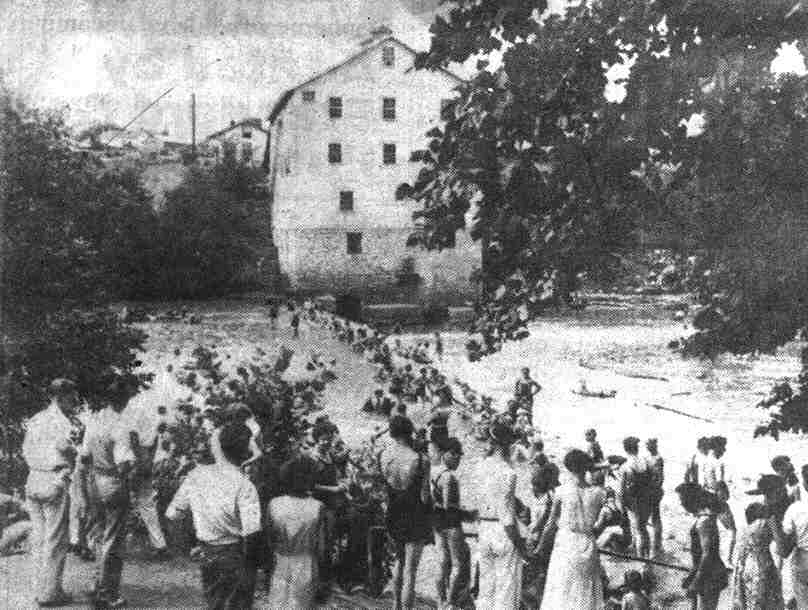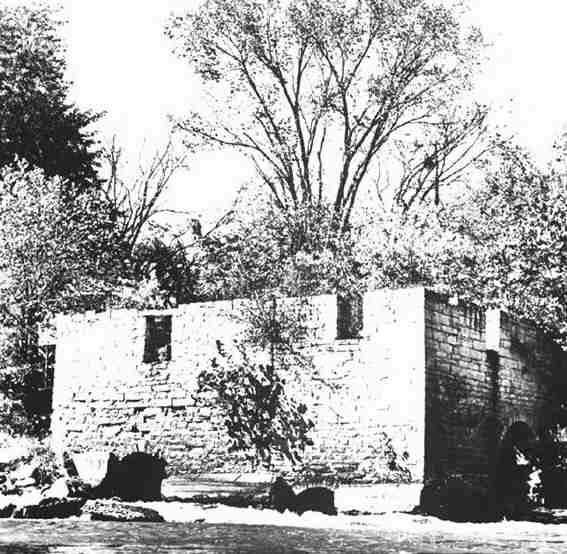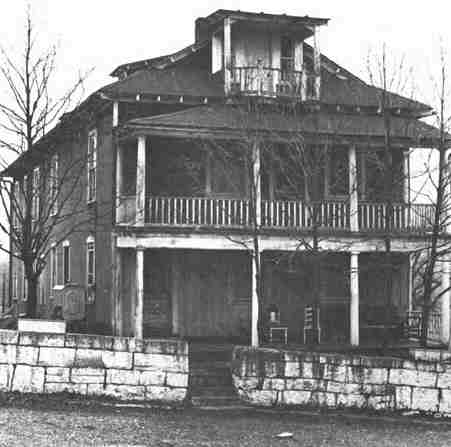
Morse Mill in its hey-day!
Photo contributed by Becky Millinger. |

This foundation is all that remains
of the old gristmill of Morse Mill, MO.
Photo contributed by Becky Millinger.
|
The town of Morse Mill, Missouri, was named for industrialist, John H. Morse, who settled in that area in 1847. Mr. Morse, a farmer and miller, came from Massachusetts and settled near the Big River about six miles northwest of Hillsboro. Morse built a majestic gristmill, which was the most prosperous and longest operational mill in southeast Missouri. Today the gristmill is but a brick foundation (see photo below) sitting on the riverbanks in a decaying town. Closed during the depression, the mill was torn down in the 1940s.
Morse was a contractor and builder and also known for building Gravois Road and the Sandy Creek Covered Bridge on Old Lemay Ferry Road. Built in 1872, the bridge still stands and is one of the few covered bridges still existing in Missouri. The bridge has been restored and a marker placed on the south end by the Jefferson County Chamber of Commerce. It is considered an important historic landmark since it provided a necessary link for Jefferson County’s road system.
In his own era, Morse was a pioneer and developer. He was known to have strong conservative views, he fought for the Confederacy in the Civil War, and was later a state senator representing parts of Jefferson and Washington Counties. He did not live to see his little town become a playground for rich tourists as he had envisioned.
Morse also built the iron frame Morse Mill Bridge that spans the Big River. The bridge is slated for destruction in the near future but preservationists are working to keep the historic bridge standing. As a child, my grandfather would play on the bridge and was often punished for unspeakable pranks against swimmers who happened under the bridge.
Built in the early 1870s, the Morse homestead was a three-story frame house with a New Orleans-style balcony on the second floor. The house was used as a motel in the Roaring 20s and its guest list boasted Charles Lindbergh and Clara Bow, Hollywood’s “It Girl”. The house is now a private residence but, sadly, is in run down condition (see photo below).
|

This is the sad condition of the old
Morse homestead in Morse Mill, MO.
Photo contributed by Becky Millinger. |

Pictured are children of James DeGonia (grandchildren of Thomas J. DeGonia, owner of this blacksmith shop):
Billy, Lyone, Maude and Alice DeGonia.
Photo contributed by Becky Millinger.
|
During the Roaring 20s Era, the river town became a thriving resort and fashionable summer haven for rich St. Louisians and their friends. The cottages on the river’s edge were home to the summer crowds who came to swim, drink and gamble, according to local historians. My great grandfather, Thomas Joseph DeGonia, operated a blacksmith shop (see photo above) at the turn of the century. One of his sons, Thomas M. DeGonia, carried on the tradition of blacksmithing until their trade went the route of the old Morse Mill Bridge. My mother remembers when my grandfather would barbecue on Sunday afternoons to cater to the resort crowd. My grandmother kept the cottages clean, sometimes cooked and together she and my grandfather earned their living serving the rich. Morse, unfortunately, did not live to see his town become the glitzy resort area that was his dream.
Postmaster, Alice Lee, is a local historian who is working to keep Morse Mill on the map. According to Lee, Morse Mill’s "resort" appeal declined when people began heading to Lake of the Ozarks earlier in the century. With the building of new highways that bypassed Morse Mill, the town’s vitality declined. The flood of 1993 washed away much of what was left of Morse Mill.
Lee tells the tale of the most infamous resident, Bertha Gifford of the Mill. Gifford, who lived in Franklin County, often volunteered to care for sick neighbors, using home remedies to treat her patients. She was called the "Good Samaritan." After several children died in her care, suspicions grew that Bertha may have been responsible. However, because children often died in this era before antibiotics, the suspicions did not go any farther. After the death of a child and his aunt, the townspeople became more than suspicious. Allegedly, Bertha predicted the deaths of many of her victims and each is said to have died with extreme stomach pain.
When the Gifford’s hired man died in her care, Bertha was arrested. Autopsies revealed that his death was from arsenic poisoning. Gifford was convinced that arsenic was a panacea and she claimed to take small quantities of the drug herself. Gifford was responsible for at least 17 deaths and of those, nine were proven to have taken place in her own home. She was found permanently insane by a jury and spent the rest of her life in a mental hospital. Lee says that Gifford was made a cook during her stay at the hospital!
Today Morse Mill is a rural town that goes unnoticed as cars fly by the
entrance to the town on Highway B. A handful of rundown cottages and
abandoned houses are a tribute to those that lived and worked in Morse Mill. Residents today still enjoy the river and the peaceful pastoral scenes that make up the town. Standing on the banks of the Big River you can hear the music and laughter of a long-forgotten era.
|
| Story taken from the St. Louis Post Dispatch article by Jeremy Kohler and Historic Sites of Jefferson County, Missouri, by Walter L. Eschbach and Malcolm C. Drummond, Harland Bartholomew and Associates, 1968.
|
|